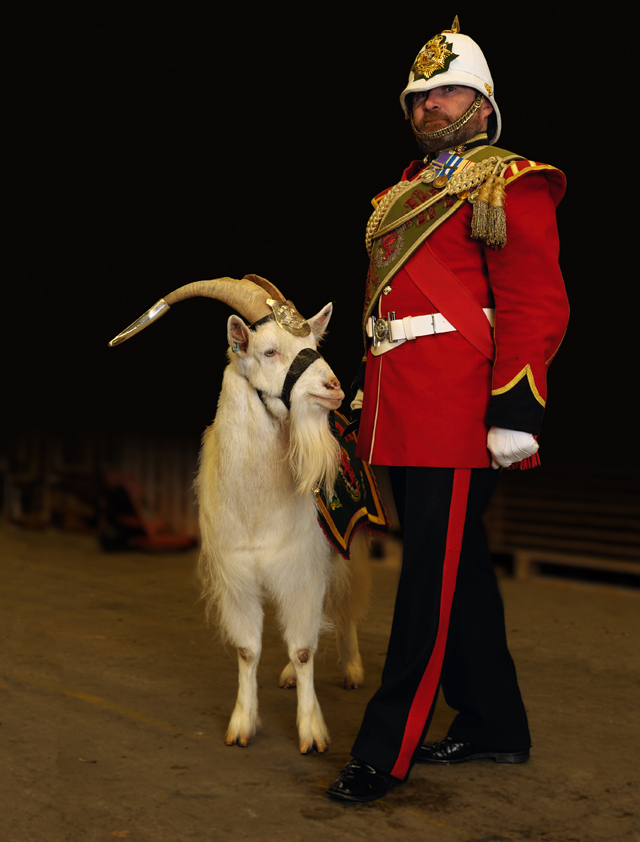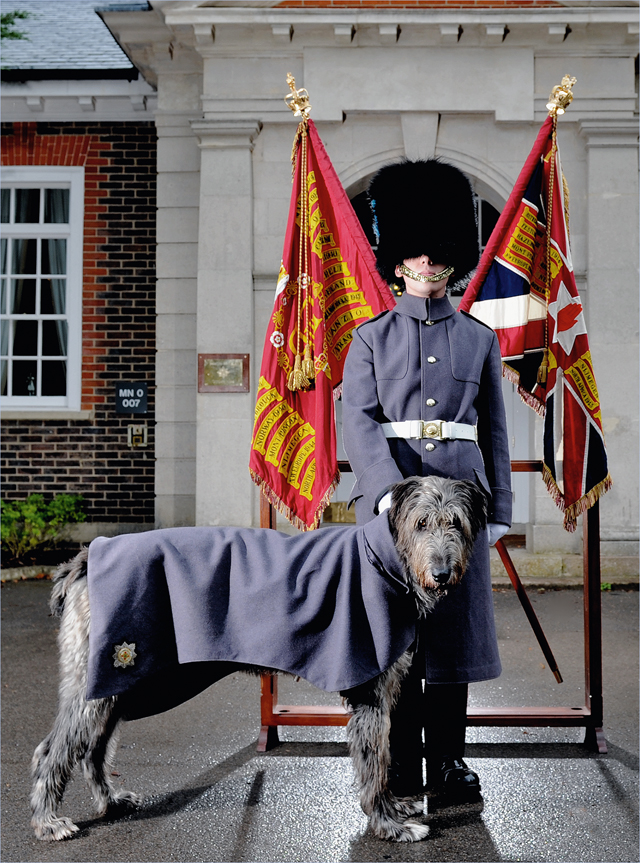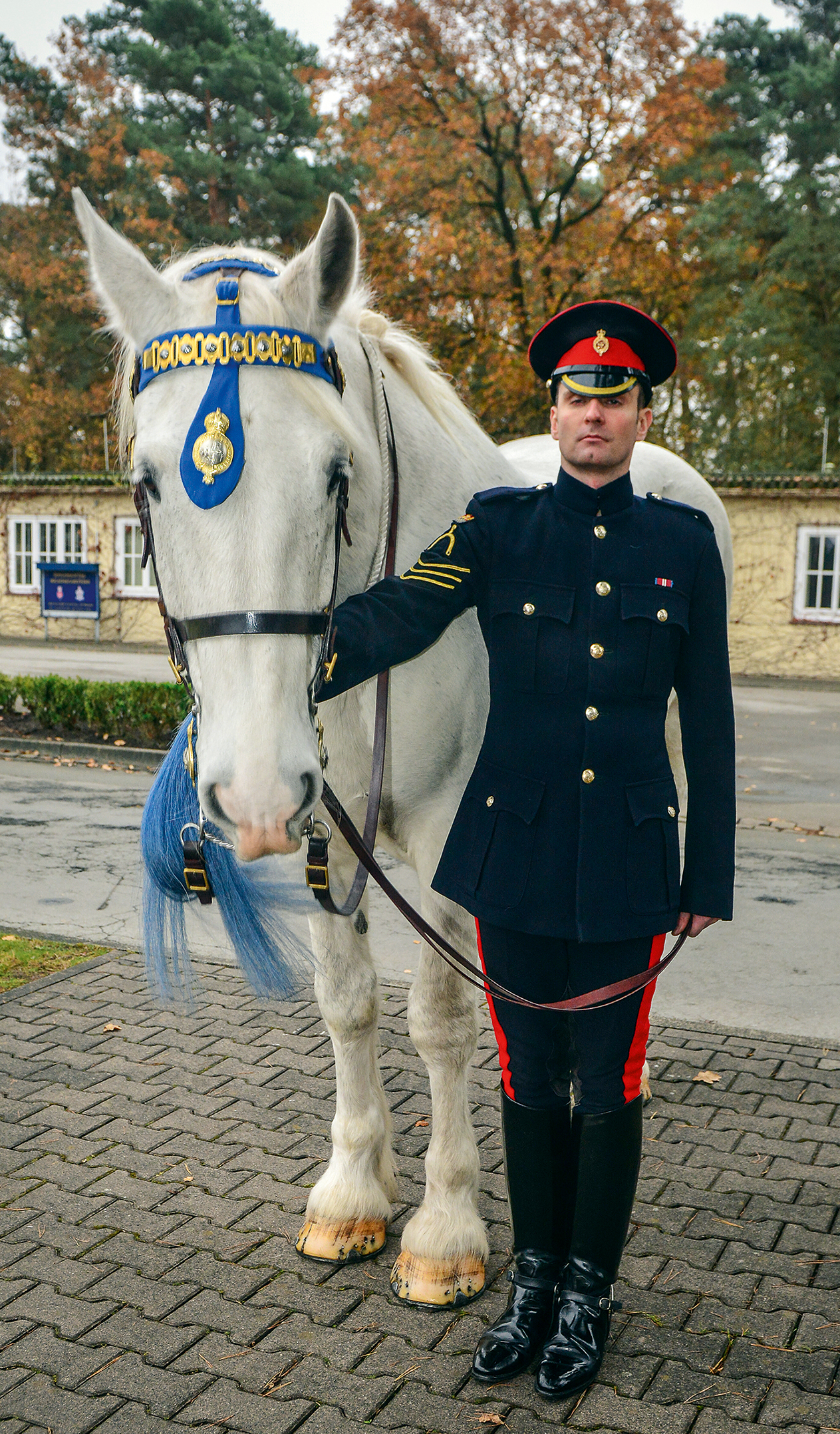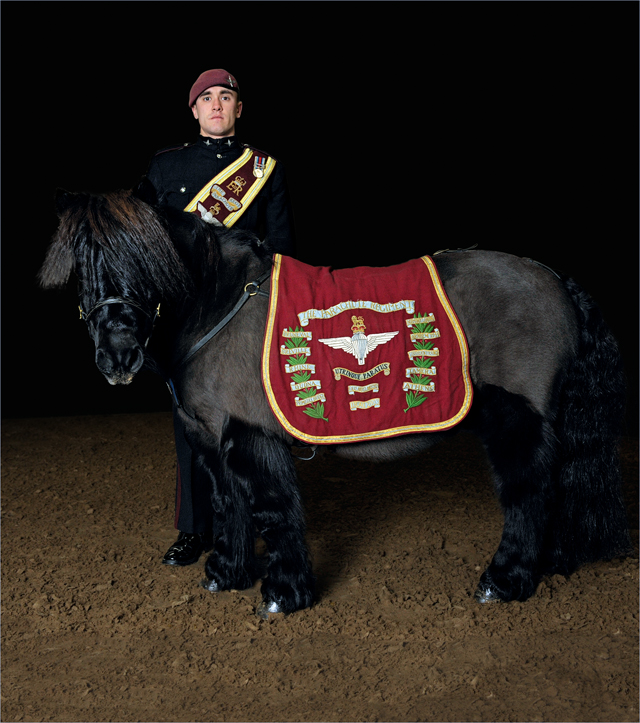Military animal mascots
Four-legged mascots are a much-loved and curious British army tradition.

One has hooves the size of dinner plates, one upstaged Father Christmas at last year’s festive gathering and another is fussy about crisp flavours. Alamein the drum horse, Private Derby the ram and Shenkin the goat are members of a privileged, elite group of official regimental mascots.
Many regiments keep unofficial pets among them ferrets, Staffordshire bull terriers and bald eagles but only eight have the stamp of approval from the British Army: two drum horses, two Shetland ponies, two Irish wolfhounds, a goat and a ram. To gain official status, a mascot must have an important symbolic significance that ties it to a regiment.
Some, such as the Mercian Regiment’s Swaledale ram and the Irish Guards’ Irish wolfhound, have a regional connection and others have historic links that can be traced back for centuries.
Intriguingly, mascots are awarded the same benefits as a soldier: they receive a regimental number and an honorary rank and are cared for at public expense. It is, by all accounts, the life of Riley. ‘The pony gets treated better than the Paras,’ jokes L/Cpl Adam Martin, who looks after Pegasus IV, the Parachute Regiment’s Shetland pony mascot.
Similarly, Shenkin the goat is used to the finer things in life, as he spends the winter tucked up in a centrally heated pen. In return for these perks, regimental mascots are permanent features in the ceremonial lives of their regiment and carry out important duties.
Shenkin III, a goat - Royal Welsh

Why? The story goes that, during a cold night in the Crimean war in 1855, one Pte Gwilym Jenkins placed a goat kid inside his coat to keep him warm. The soldier accidentally drifted off to sleep, but goats have very good hearing and when the kid heard an advancing Russian patrol, it bleated. Pte Jenkins woke, warned the forward picket and the enemy was driven off. From then on, a goat became the regiment’s symbol of good luck.
Exquisite houses, the beauty of Nature, and how to get the most from your life, straight to your inbox.
Current mascot Five-year-old Shenkin III has a particularly distinguished pedigree: he’s a direct descendant of the original mascot given to the 3rd Royal Welsh Regiment by Queen Victoria after the Crimean war. The royal connection has continued and, today, goat mascots are handpicked from The Queen’s herd in Windsor Great Park.
Shenkin III lives at Cardiff’s Maindy Barracks. ‘He prefers to stay indoors during the winter, but, in the warmer weather, he likes to spend time in his outdoor pen head-butting his favourite trees,’ says his carer, Goat Major Sgt Mark Jackson. ‘He has a selective palate he has a thing for cheese-and-onion crisps (he’ll refuse other flavours) and Savoy cabbage, but he hates carrots.’
Duties Leads out the Welsh rugby team for its home fixtures at the Millennium Stadium in Cardiff he will be doing so at this year’s 6 Nations and has walked down more red carpets than most film stars. Last June, he attended the 50th anniversary of Zulu in London’s Leicester Square, at which he met Prince Harry. ‘He’s an out-and-out poser; he’ll puff out his chest when he sees a camera,’ reveals Sgt Jackson, who also takes Shenkin to visit local schools.
Domhnall, an Irish wolfhound - Irish Guards

Why?
The first mascot was presented to the Irish Guards in 1902 by members of the Irish Wolfhound Club of Northern Ireland, who hoped the publicity would increase the breed’s popularity with the public. His name was Brian Boru after one of Ireland’s famous chieftains. There have been 15 successors.
Current mascot Domhnall, whose name means ‘world leader’ in Gaelic. He’s based at Mons Barracks in Aldershot, Hampshire. Many of the dog’s ceremonial duties are with the Household Cavalry Mounted Regiment, so Domhnall had to be trained to cope with the noises, sights and sounds of London, as well as becoming familiar with horses.
His handler, Drummer David Steed, admitted that, as a pup, the wolfhound’s favourite occupation was chasing cyclists. During last year’s Irish state visit to Windsor Castle, President Michael Higgins presented Domhnall with a red ceremonial coat. Apparently, this returned a gesture of friendship made by the regiment during the First World War, when soldiers from the Irish Guards spotted a hound from another Irish regiment shivering in the trenches and wrapped it up in a spare coat.
Duties Ceremonial duties include The Queen’s Birthday Parade, the St Patrick’s Day Parade and the first stage of Trooping the Colour, in which Domhnall marches from Wellington Barracks to Horse Guards Parade.
Alamein, a drum horse - Queen’s Royal Hussars

Why?
The Queen’s Royal Hussars has always had a drum horse. The tradition dates back to George II, who commanded that, on ceremonial occasions, a horse should carry a set of silver drums captured from the French during the Battle of Dettingen in 1743. The replica kettledrums used today are engraved with the 3rd Hussars’ battle honours (an antecedent regiment) and are uncovered, unlike any others belonging to the British Army.
The Queen Mother presented the regiment with two drum horses: Peninsula, a grey Clydesdale, in 1988, and Winston, who died in 2006.
Current mascot A gift from The Duke of Edinburgh, Colonel-in-Chief of The Queen’s Royal Hussars, the colossal grey Irish gelding, Alamein, stands at some 18hh and is named after one of the regiment’s battle honours. When he first joined, his groom, L/Cpl Brent Evans, described the horse as ‘fairly massive, he’s got very big hooves and he likes fingers’. Alamein was nicknamed Dudley after the West Midlands town in which many new troops are recruited.
Broken in by L/CoH Daniel Veness of the Household Cavalry in 2008, Alamein is kept at Paderborn Equestrian Centre, near Athlone Barracks in Sennelager, Germany.
Duties His main role is to carry the kettledrummer and stand still while on parade, so, although he’s exercised in hand every day, he rarely gets ridden. Among the skills a drum horse has to learn is to be steered by his rider’s feet. Alamein carries the kettle drums and marches at the front of the regiment for all ceremonial parades.
Pegasus IV, a Shetland pony -
Parachute Regiment

Why?
The regiment’s first pony mascot dates back to 1950, when the 1st Battalion was presented with a black New Forest gelding called Pegasus I a nod to the regiment’s triumphant Pegasus Bridge raid that marked the beginning of D-Day in 1944. Other battalions also acquired ponies, but a decision was taken to keep just one.
In 1962, Sergeant Ringway, a miniature skewbald Shetland stallion, became the regiment’s first official mascot. He proved a huge hit with the soldiers and the public and, when he died in 1975, obituary notices were placed in The Times and The Daily Telegraph.
Current mascot Pegasus IV lives at the Colchester Garrison Saddle Club. ‘He’s waited on hand and foot,’ jokes his handler, L/Cpl Adam Martin. ‘He’s pretty laid back and no bother to look after, unlike his companion Bruno [another Shetland], who runs riot.’
Duties Last year, Pegasus attended various D-Day commemorations and travelled to Arnhem in Holland to take part in parades to mark the 70th anniversary of Operation Market Garden, the largest airborne operation in history. He makes a monthly appearance at the Catterick Garrison passing-out parades. ‘The only time he gets revved up is when he hears bagpipes and loud clapping they make him rear,’ says L/Cpl Martin.
Private Derby XXX, a Swaledale ram - Mercian Regiment

Why?
The first Private Derby was adopted as a mascot in 1858 by the 95th (Derbyshire) Regiment at the siege of Kotah during the Indian Mutiny campaign. During a foray into town, the commanding officer spied a fine-looking ram tethered in a temple yard. He took it into his possession and named it Private Derby.
The ram marched nearly 3,000 miles through central India before it died in 1863. When the Mercian Regiment was formed in 2007 from the amalgamation of two other regiments that had links back to Kotah, Private Derby became its official mascot.
Current mascot Private Derby XXX, a pedigree Swaledale ram given to the regiment by the Duke of Devonshire, who bred him at Chatsworth. He lives at the Mercian Regiment’s Whittington Barracks in Lichfield, Staffordshire, where he has two handlers Ram Major Cpl Philip Thornton and Ram Orderly Pte Jake Seager. ‘He gets taken out for two one-mile walks a day,’ explains Cpl Thornton. ‘He covers a lot of miles on duty, so it’s important he’s fit.’
Private Derby has his own army ID card, is paid a full salary that goes into his account at the local feed merchant and is entitled to annual leave, which he uses to visit Chatsworth during the mating season. ‘It’s like a Club 18–30 holiday,’ jokes Cpl Thornton.
Duties Numerous and varied. Leads out Derby County football team for its home matches, attends charity functions and regularly takes part in homecoming parades. He caused a stir in December in nearby Ashbourne, where he turned on the Christmas lights by flipping a specially designed switch. ‘He attracted so much attention that Father Christmas was left twiddling his thumbs,’ laughs Cpl Thornton.
Horses & the War
Read our amazing selection of images and articles on horses during the First World War, from their role at the

Dogs and the First World War
Matthew Dennison looks at the roles of at least 20,000 dogs who were involved in the First World War.